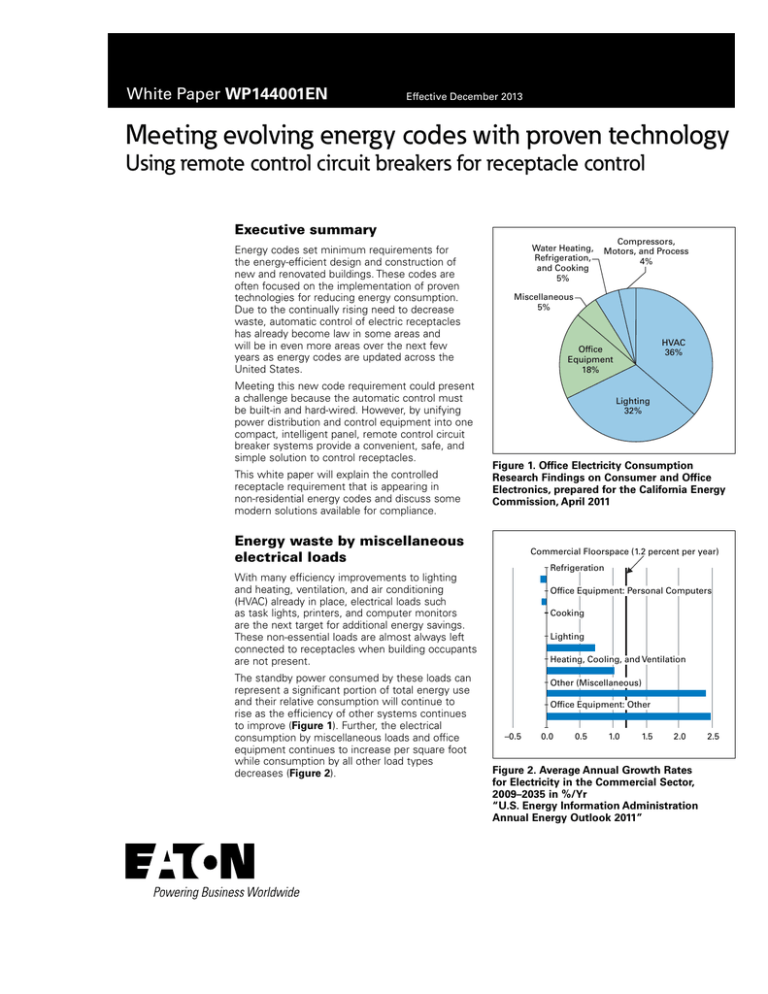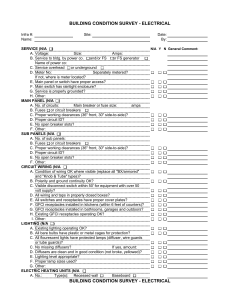
White Paper WP144001EN
Effective December 2013
Meeting evolving energy codes with proven technology
Using remote control circuit breakers for receptacle control
Executive summary
Energy codes set minimum requirements for
the energy-efficient design and construction of
new and renovated buildings. These codes are
often focused on the implementation of proven
technologies for reducing energy consumption.
Due to the continually rising need to decrease
waste, automatic control of electric receptacles
has already become law in some areas and
will be in even more areas over the next few
years as energy codes are updated across the
United States.
Meeting this new code requirement could present
a challenge because the automatic control must
be built-in and hard-wired. However, by unifying
power distribution and control equipment into one
compact, intelligent panel, remote control circuit
breaker systems provide a convenient, safe, and
simple solution to control receptacles.
This white paper will explain the controlled
receptacle requirement that is appearing in
non-residential energy codes and discuss some
modern solutions available for compliance.
Water Heating,
Refrigeration,
and Cooking
5%
Miscellaneous
5%
HVAC
36%
Office
Equipment
18%
Lighting
32%
Figure 1. Office Electricity Consumption
Research Findings on Consumer and Office
Electronics, prepared for the California Energy
Commission, April 2011
Energy waste by miscellaneous
electrical loads
Commercial Floorspace (1.2 percent per year)
Refrigeration
With many efficiency improvements to lighting
and heating, ventilation, and air conditioning
(HVAC) already in place, electrical loads such
as task lights, printers, and computer monitors
are the next target for additional energy savings.
These non-essential loads are almost always left
connected to receptacles when building occupants
are not present.
The standby power consumed by these loads can
represent a significant portion of total energy use
and their relative consumption will continue to
rise as the efficiency of other systems continues
to improve (Figure 1). Further, the electrical
consumption by miscellaneous loads and office
equipment continues to increase per square foot
while consumption by all other load types
decreases (Figure 2).
Compressors,
Motors, and Process
4%
Office Equipment: Personal Computers
Cooking
Lighting
Heating, Cooling, and Ventilation
Other (Miscellaneous)
Office Equipment: Other
–0.5
0.0
0.5
1.0
1.5
2.0
Figure 2. Average Annual Growth Rates
for Electricity in the Commercial Sector,
2009–2035 in %/Yr
“U.S. Energy Information Administration
Annual Energy Outlook 2011”
2.5
White Paper WP144001EN
Meeting evolving energy codes with proven technology
Effective December 2013
Automatic control of receptacles
Control methods
To address these areas of waste, energy codes are beginning
to require automatic control of electric receptacles. These
codes mandate that controlled receptacles must be provided in
environments such as private offices, open office areas, computer
classrooms, reception lobbies, conference rooms, and office
kitchenettes. Under the requirement, at least one switched receptacle
must be provided within six feet of each uncontrolled receptacle.
Split-wired duplex receptacles, with one outlet controlled and one
outlet uncontrolled, are another viable option. The occupant ultimately
decides which plug-in loads are suitable for automatic shutoff.
Both time schedule and occupancy sensor lighting control methods
are appropriate for receptacle control because both are designed to
reduce energy consumption when occupants are not present. But
selecting the method requires consideration. For example, using a
time schedule to control a receptacle is universally applicable to plug
loads in all areas. Using occupancy sensors to control receptacles
can provide incremental energy savings beyond time schedules by
responding to unoccupied periods that may randomly occur during
the day. For this reason, occupancy sensors are very well suited to
small spaces such as private offices or conference rooms, but will
only provide energy savings equal to time schedules in larger areas
that are continuously occupied during normal hours.
Open space areas intended for cubicle workstations present a
unique challenge. If the cubicles are already installed at the time
of inspection, it becomes possible to verify if the cubicles are
equipped with local devices to control the receptacles. However,
many buildings are constructed for future lease and without a
specific cubicle layout plan. In these situations, controlled circuits
must be provided for the open space areas. Both the controlled
and uncontrolled circuits will have to be clearly marked to allow for
inspection and future connection. When eventually connected, the
controlled receptacles will be automatically switched off using the
preferred method.
Lighting control application extended
The California Energy Commission sponsored a study to investigate
the feasibility and cost-effectiveness of automatically shutting
off plug-in loads via controlled receptacles. The study team used
research data on power consumption and status of plug-in load
devices to estimate the potential energy savings, focusing only on
the loads that could be switched off without disruption when the
occupant is away or when the office is closed.
The study team discovered that receptacle circuits could be easily
controlled using the same equipment commonly installed to control
lighting. This discovery provided a lower-cost approach to obtaining
energy savings, as automatic lighting controls are readily available
and this proven technology is widely understood. But it was noted
that plug-in controllable power strips should not be allowed because
they could be easily removed.
Remote
Controlled
Breaker
Panelboard
It is important to note that occupancy sensors would not be
appropriate for equipment that should not be turned off during
business hours, such as a shared printer or a water cooler. For
these reasons, a combined approach using time schedule control
in general and optionally using occupancy control in appropriate
locations can yield higher energy savings at the lowest cost.
It is also worth noting that, similar to lighting systems, energy
codes will allow the use of a signal from another system to control
receptacles. This signal may come from a building automation
system or may use something as simple as the “armed away”
status of the security alarm in a small office situation.
Power switching options
Figure 3 shows a simplified representation of three power switching
methods using technology commonly used for lighting control.
Controlled receptacle circuits can be switched by either a remote
controlled circuit breaker panelboard (A), a lighting relay panel (B), or
by a relay (C) driven by an occupancy sensor. Control panels typically
contain an internal time clock for time-of-day control and are also
capable of responding to external signals via simple connection.
Network connections allow remote monitoring via software or Web
page. While they are typically standalone, some occupancy sensors
offer system connectivity options as well.
Controlled
(A) Controllable Circuit Breaker Panelboard
Uncontrolled
Standard
Circuit
Breaker
Panelboard
Lighting
Relay
Panel
Controlled
(B) Lighting Relay Panel
Uncontrolled
Key
Time
Occupancy
Signal
Standard
Circuit
Breaker
Panelboard
Sensor Driven
Relay
Network
Controlled
Uncontrolled
Figure 3. Receptacle Power Switching Options
2
EATON www.eaton.com
Relay
(C) Relay Driven by Occupancy Sensor
Breaker
Meeting evolving energy codes with proven technology
White Paper WP144001EN
Effective December 2013
Advantages of controllable circuit breakers
Controllable circuit breakers offer many advantages when they are
used to switch receptacles. A circuit breaker is always required to
protect the connected circuit. A remote-controlled circuit breaker
provides the required circuit protection but eliminates the need to
provide an additional device for switching. There is no additional
labor for installation and no additional connections to establish and
troubleshoot (Figure 4).
Further, having receptacle control embedded inside the distribution
panelboard reduces the amount of material required and saves
space in the electric closet. All of the equipment is concentrated in
one place for simple verification, and the panelboard directory can
be marked to indicate the controlled circuits that correspond to the
designated switched receptacles.
A controllable circuit breaker solution also offers several advantages
for building occupants. Because circuit breakers are designed to
interrupt and survive a short-circuit condition, a circuit breaker would
only need to be reset if a short circuit were to occur when a load is
plugged into a receptacle. Other types of switching devices could
be damaged, requiring service by a qualified electrician. Another
advantage is the mechanical override feature typically found on
controllable circuit breakers. This easy-to-access mechanism allows
power to be restored to a load in the event of a control failure. If
the override type is temporary, the energy-saving operation will be
automatically restored along with the control function.
Controllable
Circuit Breaker
N
Figure 4. Receptacle Control Using Controllable Circuit Breaker
Controlling receptacles located in
the same wall box
While code requirements will allow controlled and uncontrolled
receptacles to be as much as six feet apart, it is likely that they will
be located in the same wall box to save material and labor costs.
When two circuits are located in the same wall box, a method
to simultaneously disconnect both circuits may be desired or
even required.
Circuit breakers can be easily and simultaneously disconnected
by joining their handles together with a handle tie (Figure 5).
Handle-tied circuits are inherently on different phases, which can
have additional advantages.
Circuits that are fed from different phases are allowed to share
the same neutral conductor because the neutral currents from
each circuit will partially cancel each other. Not only will sharing a
neutral conductor eliminate a wire and the space that it takes up in
a conduit, some additional energy is saved because the cancellation
reduces voltage loss and heat.
Handle Tie
Controllable
Circuit Breaker
N
Standard
Circuit Breaker
Figure 5. Split Receptacle Control Using Controllable Circuit Breakers
EATON www.eaton.com
3
White Paper WP144001EN
Meeting evolving energy codes with proven technology
Effective December 2013
Receptacle breaker
About Eaton
It should be noted that installing a handle tie across adjacent circuit
breakers does not provide a common trip function. If common
trip is desired, an internal trip bar must be present to ensure that
an overload on one pole will trip the other pole. Internal trip bars
are not an accessory but must be installed in the breaker at the
time of manufacture. Remote-control circuit breakers designed for
receptacle applications combine controlled and uncontrolled poles
with common trip and a handle tie (Figure 6).
Eaton’s electrical business is a global leader with expertise in
power distribution and circuit protection, backup power protection,
control and automation, lighting and security, structural solutions
and wiring devices, solutions for harsh and hazardous environments,
and engineering services. Eaton is positioned through its
global solutions to answer today’s most critical electrical power
management challenges.
Eaton is a power management company providing energy-efficient
solutions that help our customers effectively manage electrical,
hydraulic, and mechanical power. A global technology leader, Eaton
acquired Cooper Industries plc in November 2012. The 2012 revenue
of the combined companies was $21.8 billion on a pro forma basis.
Eaton has approximately 102,000 employees and sells products to
customers in more than 175 countries. For more information, visit
www.eaton.com.
About the author
Figure 6. Receptacle Breaker
Conclusion
When selecting products for energy savings and code compliance, it
is important to consider the advantages and the flexibility of remotecontrolled circuit breakers. These systems bring power distribution
and control together into one compact, intelligent panel while
reducing the need for additional equipment and complex wiring.
Drew Reid is the Product Line Manager for Eaton’s Lighting
Control and Building Management business, featuring the innovative
Pow-R-Command system for lighting and building control. He is a
Certified Energy Manager and Certified Energy Auditor with more
than 30 years of experience in the marketing and engineering of
control systems, software, and communication networks. He has
17 U.S. patents with additional patents pending. He can be reached
at DrewAReid@eaton.com.
For many years, remote-control circuit breaker systems have been
an obvious choice for managing electrical power and lighting, widely
used from small facilities to the world’s largest buildings. Applying
these solutions for receptacle control is simply a new application for
this versatile type of system.
Eaton
1000 Eaton Boulevard
Cleveland, OH 44122
United States
Eaton.com
© 2013 Eaton
All Rights Reserved
Printed in USA
Publication No. WP144001EN / Z14608
December 2013
Eaton is a registered trademark.
All other trademarks are property
of their respective owners.


